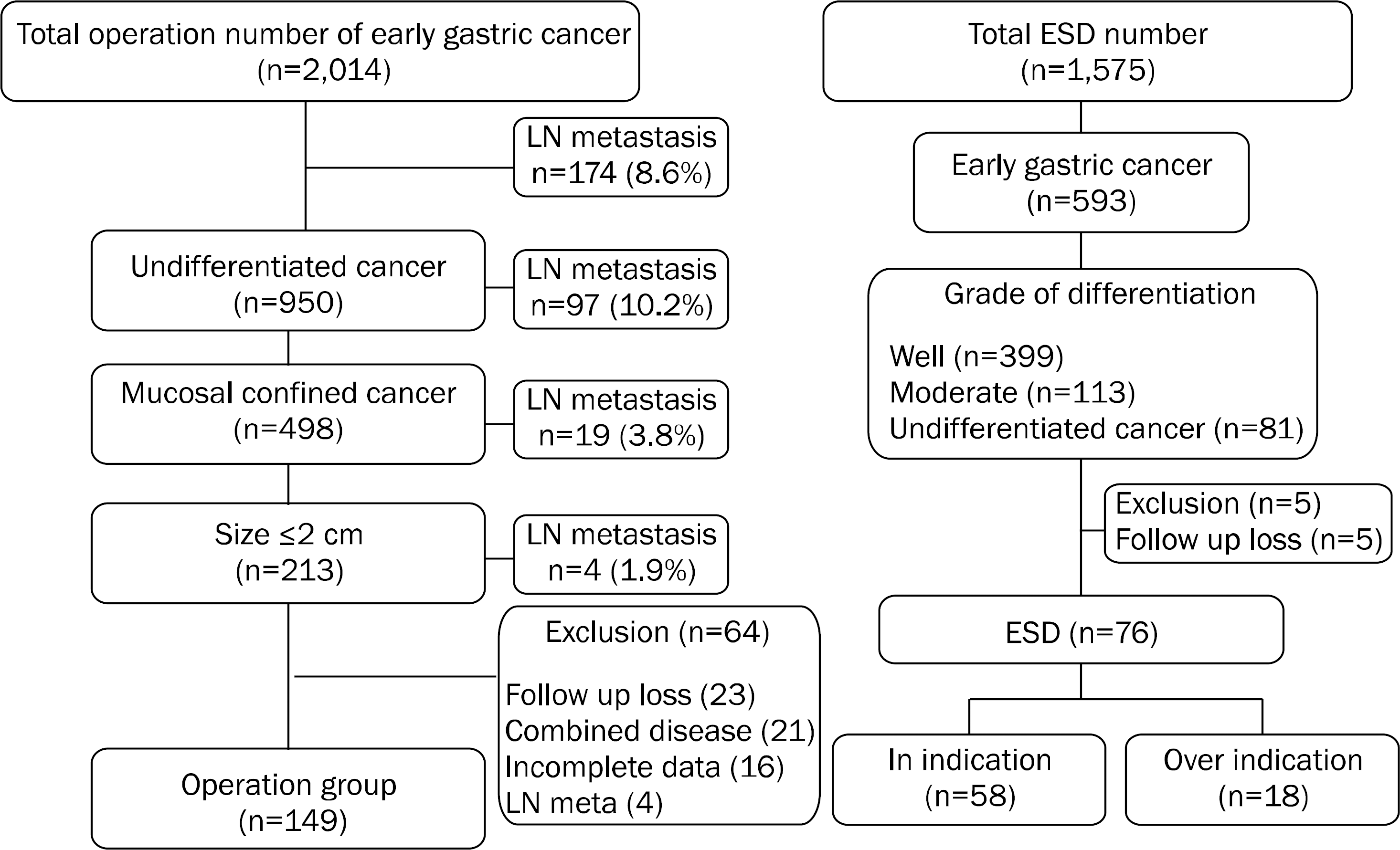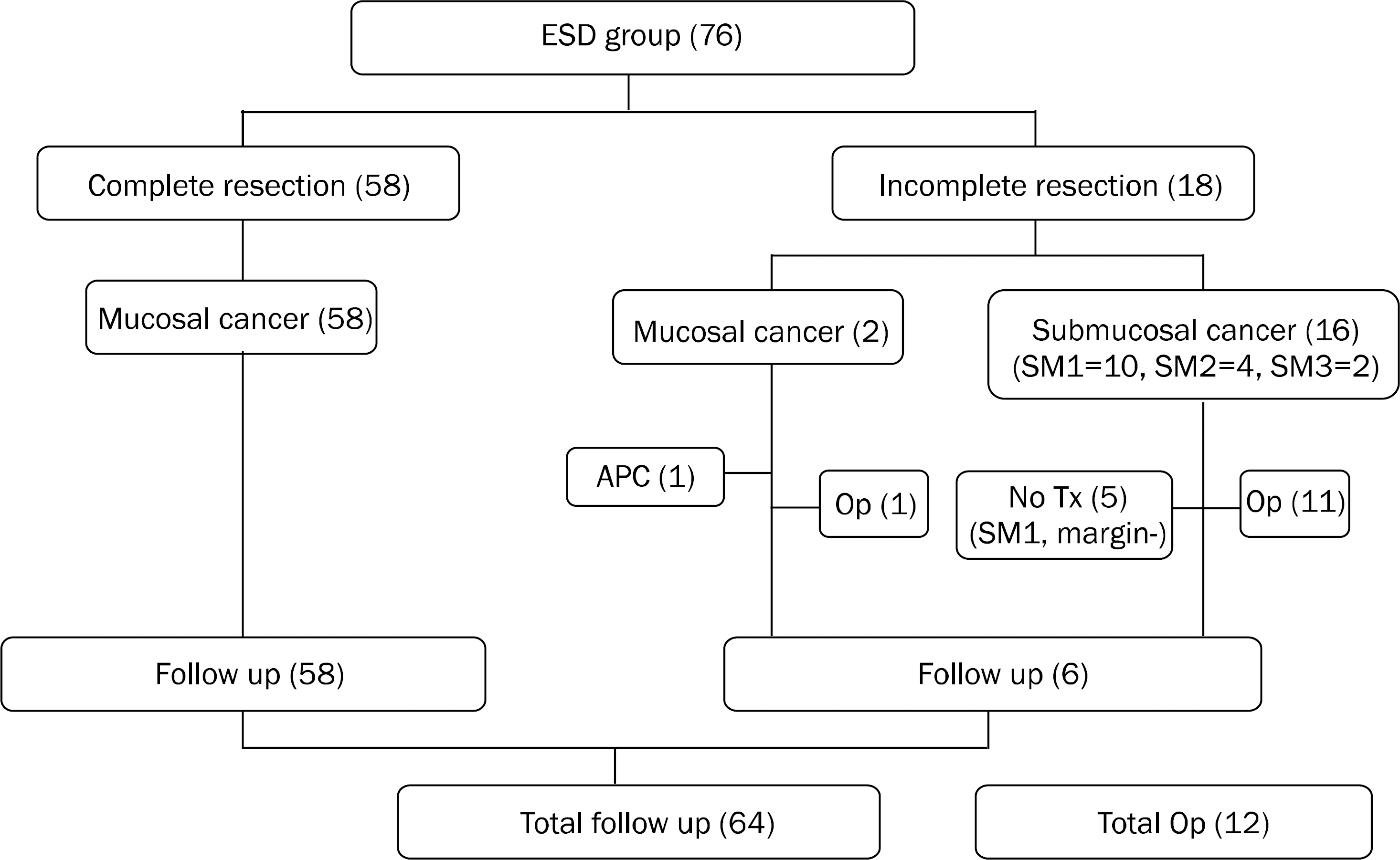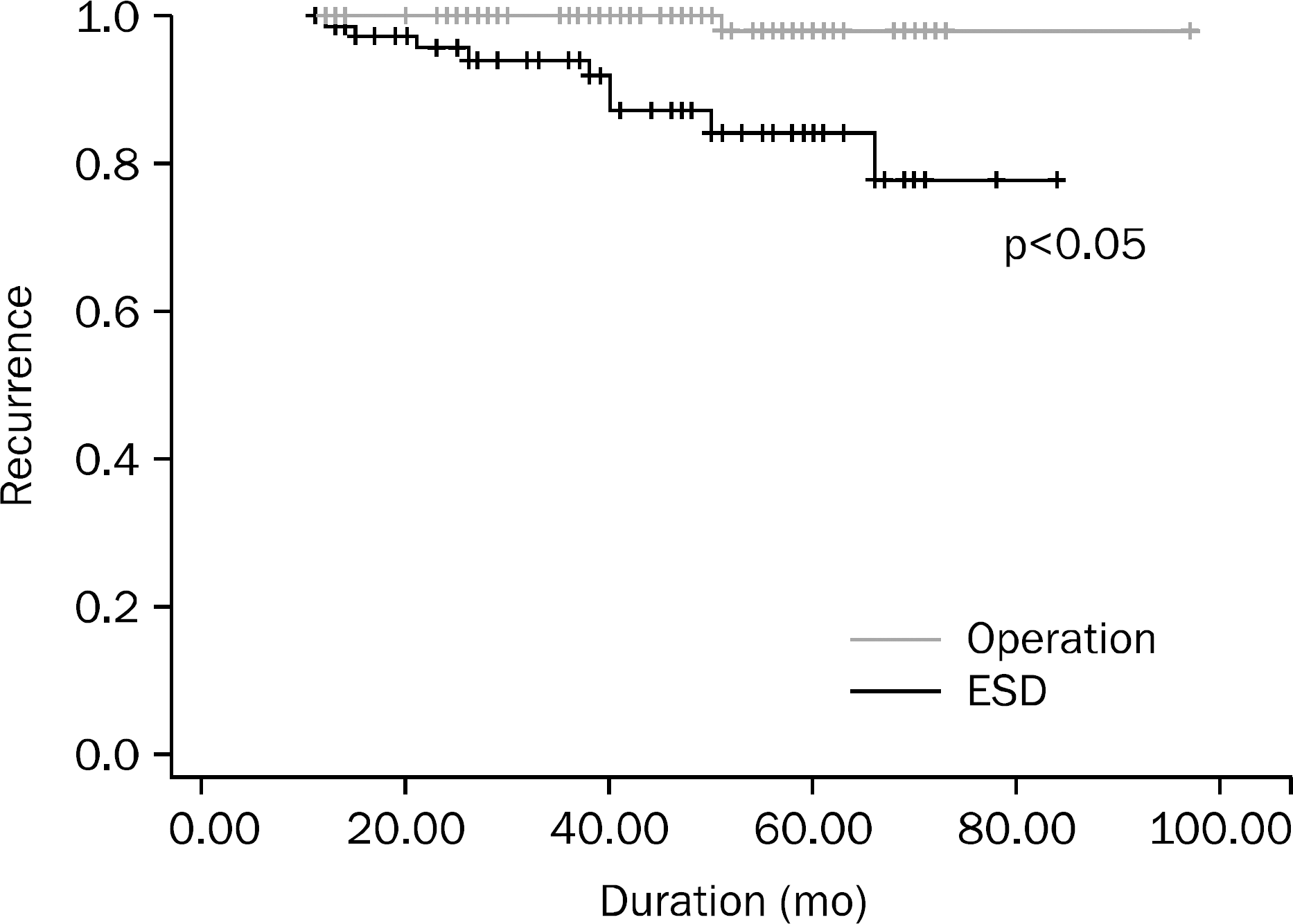Abstract
Background/Aims
There are controversies on the efficacy and safety of endoscopic submucosal dissection (ESD) for undifferentiated early gastric cancer (EGC) despite the expansion of ESD indications. The aim of this study was to evaluate the long term outcome of ESD compared to that of surgical treatment in patients with undifferentiated EGC.
Methods
A total of 76 patients who underwent ESD for undifferentiated EGC and 149 patients who met the ESD indication and received surgical treatment from January 2005 to December 2010 at Chonnam National University Hwasun Hospital were included.
Results
In the ESD group, en bloc resection and complete resection were achieved in 84.2% (64/76) and 76.3% (58/76) of patients, respectively. Among these patients, 58 (76.3%) met the ESD indication (indication group), and the remaining 18 (23.7%) did not meet the ESD indication (above indication group). Complete resection rates for indication group and above indication group were 86.2% (50/58) and 44.4% (8/18), respectively (p<0.05). The mean follow-up period was 42.2±19.2 months. Total recurrence rates in the ESD group and operation group were 14.1% (9/76) and 0.7% (1/149), respectively (p<0.05). The main complication of ESD was bleeding (5.2%, 4/76). In the operation group, 2 (1.3%) patients died from postoperative bleeding and leakage of anastomosis site.
Go to : 
References
2. Gotoda T, Yanagisawa A, Sasako M, et al. Incidence of lymph node metastasis from early gastric cancer: estimation with a large number of cases at two large centers. Gastric Cancer. 2000; 3:219–225.

3. Tada M, Murakami A, Karita M, Yanai H, Okita K. Endoscopic re-section of early gastric cancer. Endoscopy. 1993; 25:445–450.

4. Kamada K, Tomatsuri N, Yoshida N. Endoscopic submucosal dissection for undifferentiated early gastric cancer as the expanded indication lesion. Digestion. 2012; 85:111–115.

5. Kang HY, Kim SG, Kim JS, Jung HC, Song IS. Clinical outcomes of endoscopic submucosal dissection for undifferentiated early gastric cancer. Surg Endosc. 2010; 24:509–516.

6. Kim JH, Lee YC, Kim H, et al. Endoscopic resection for undifferentiated early gastric cancer. Gastrointest Endosc. 2009; 69:e1–e9.
7. Okada K, Fujisaki J, Yoshida T, et al. Long-term outcomes of endoscopic submucosal dissection for undifferentiated-type early gastric cancer. Endoscopy. 2012; 44:122–127.

8. Park J, Choi KD, Kim MY, et al. Is endoscopic resection an acceptable treatment for undifferentiated EGC? Hepatogastroenterology. 2012; 59:607–611.

9. Yamamoto Y, Fujisaki J, Hirasawa T, et al. Therapeutic outcomes of endoscopic submucosal dissection of undifferentiated-type intramucosal gastric cancer without ulceration and pre-operatively diagnosed as 20 millimetres or less in diameter. Dig Endosc. 2010; 22:112–118.

10. Abe N, Watanabe T, Sugiyama M, et al. Endoscopic treatment or surgery for undifferentiated early gastric cancer? Am J Surg. 2004; 188:181–184.

11. Nasu J, Nishina T, Hirasaki S, et al. Predictive factors of lymph node metastasis in patients with undifferentiated early gastric cancers. J Clin Gastroenterol. 2006; 40:412–415.

12. Park YD, Chung YJ, Chung HY, et al. Factors related to lymph node metastasis and the feasibility of endoscopic mucosal resection for treating poorly differentiated adenocarcinoma of the stomach. Endoscopy. 2008; 40:7–10.

13. Ye BD, Kim SG, Lee JY, et al. Predictive factors for lymph node metastasis and endoscopic treatment strategies for undifferentiated early gastric cancer. J Gastroenterol Hepatol. 2008; 23:46–50.

14. Akahoshi K, Chijiwa Y, Hamada S, et al. Pretreatment staging of endoscopically early gastric cancer with a 15 MHz ultrasound catheter probe. Gastrointest Endosc. 1998; 48:470–476.

15. Japanese Gastric Cancer Association. Japanese classification of gastric carcinoma: 3rd English edition. Gastric Cancer. 2011; 14:101–112.
16. Reshamwala PA, Darwin PE. Endoscopic management of early gastric cancer. Curr Opin Gastroenterol. 2006; 22:541–545.

17. Ohkuwa M, Hosokawa K, Boku N, Ohtu A, Tajiri H, Yoshida S. New endoscopic treatment for intramucosal gastric tumors using an insulated-tip diathermic knife. Endoscopy. 2001; 33:221–226.

18. Kurihara N, Kubota T, Otani Y, et al. Lymph node metastasis of early gastric cancer with submucosal invasion. Br J Surg. 1998; 85:835–839.

19. Park DJ, Lee HK, Lee HJ, et al. Lymph node metastasis in early gastric cancer with submucosal invasion: feasibility of minimally invasive surgery. World J Gastroenterol. 2004; 10:3549–3552.

20. Yamada H, Nihei Z, Yamashita T, Shirota Y, Ichikawa W, Sugihara K. Is lymphadenectomy needed for all submucosal gastric cancers? Eur J Surg. 2001; 167:199–203.
21. Soetikno R, Kaltenbach T, Yeh R, Gotoda T. Endoscopic mucosal resection for early cancers of the upper gastrointestinal tract. J Clin Oncol. 2005; 23:4490–4498.

22. Oda I, Saito D, Tada M, et al. A multicenter retrospective study of endoscopic resection for early gastric cancer. Gastric Cancer. 2006; 9:262–270.

23. Gotoda T, Yamamoto H, Soetikno RM. Endoscopic submucosal dissection of early gastric cancer. J Gastroenterol. 2006; 41:929–942.

24. Choi MH, Hong SJ, Han JP, et al. Therapeutic outcomes of endoscopic submucosal dissection in undifferentiated-type early gastric cancer. Korean J Gastroenterol. 2013; 61:196–202.

25. Ono H, Kondo H, Gotoda T, et al. Endoscopic mucosal resection for treatment of early gastric cancer. Gut. 2001; 48:225–229.

26. Takeuchi Y, Uedo N, Iishi H, et al. Endoscopic submucosal dissection with insulated-tip knife for large mucosal early gastric cancer: a feasibility study (with videos). Gastrointest Endosc. 2007; 66:186–193.

27. Miyamoto S, Muto M, Hamamoto Y, et al. A new technique for endoscopic mucosal resection with an insulated-tip electrosurgical knife improves the completeness of resection of intramucosal gastric neoplasms. Gastrointest Endosc. 2002; 55:576–581.

28. Kim JJ, Lee JH, Jung HY, et al. EMR for early gastric cancer in Korea: a multicenter retrospective study. Gastrointest Endosc. 2007; 66:693–700.
Go to : 
 | Fig. 1.Flow chart of patient inclusion. LN, lymph node; ESD, endoscopic submucosal dissection. |
 | Fig. 2.Clinical courses after the endoscopic submucosal dissection (ESD) for undifferentiated early gastric cancer.
APC, argon plasma coagulation; Tx, treatment; Op, operation.
|
 | Fig. 3.Kaplan-Meier curve of recurrence rates in patients with undifferentiated early gastric cancer after endoscopic submucosal dissection (ESD) or gastrectomy. |
Table 1.
Clinical Characteristics
| Parameter |
ESD group (n=76) |
Operation group (n=149) | p-value | |
|---|---|---|---|---|
| Indication group∗ (n=58) | Above indication group (n=18) | |||
| Age (yr) | 60.1±13.2 | 64.9±9.6 | 56.7±12.8 | 0.013 |
| Sex (male/female) | 34/24 | 10/8 | 72/77 | 0.174 |
| Location | 0.147 | |||
| Upper third | 1 (1.7) | 1 (5.6) | 12 (8.1) | |
| Mid third | 35 (60.3) | 12 (66.7) | 76 (51.0) | |
| Lower third | 22 (37.9) | 5 (27.8) | 61 (40.9) | |
| Horizontal location | 0.536 | |||
| Anterior wall | 12 (20.7) | 6 (33.3) | 38 (25.5) | |
| Great curvature | 15 (25.9) | 4 (22.2) | 25 (16.8) | |
| Posterior wall | 11 (19.0) | 3 (16.7) | 31 (20.8) | |
| Lesser curvature | 20 (34.5) | 5 (27.8) | 55 (36.9) | |
| Gross type | 0.005 | |||
| Depressed | 18 (31.0) | 7 (38.9) | 89 (59.7) | |
| Flat | 20 (34.5) | 7 (38.9) | 32 (21.5) | |
| Elevated | 20 (34.5) | 4 (22.2) | 28 (18.8) | |
| Size (cm) | 0.001 | |||
| ≤1 | 14 (24.1) | 0 (0) | 41 (27.5) | |
| >1, ≤2 | 44 (75.9) | 0 (0) | 108 (72.5) | |
| >2, ≤4 | 0 (0) | 15 (83.3) | 0 (0) | |
| >4 | 0 (0) | 3 (16.7) | 0 (0) | |
| Operation method | ||||
| Laparoscopic | NA | NA | 105 (70.5) | |
| Open | NA | NA | 44 (29.5) | |
Table 2.
Clinical Characteristics of Poorly Differentiated Adenocarcinoma and Signet Ring Cell Carcinoma in ESD Patients
Table 3.
Treatment Efficacy of Endoscopic Submucosal Dissection (ESD) for Undifferentiated Early Gastric Cancer
Table 4.
Clinical Outcomes after Long Term Follow Up in Endoscopic Submucosal Dissection (ESD) and Operation Group
| Parameter | ESD group (n=64) | Operation group (n=149) | p-value |
|---|---|---|---|
| Mean duration of follow up (mo) | 41.7±22.6 | 42.8±17.3 | 0.703 |
| Total recurrence of cancer after initial treatment | 9 (14.1) | 1 (0.7) | 0.001 |
| Intragastric | 8 (12.5) | 1 (0.7) | |
| Lymph node | 1 (1.6) | 0 (0) | |
| Synchronous intragastric lesion (≤12 mo) | 0.001 | ||
| Carcinoma | 6 (9.3) | 0 (0) | |
| Dysplasia | 1 (1.6) | 0 (0) | |
| Metachronous intragastric lesion | 0.036 | ||
| Carcinoma | 2 (3.1) | 1 (0.7) | |
| Dysplasia | 1 (1.6) | 0 (0) | |
| Site of new lesion (carcinoma+dysplasia) | 0.001 | ||
| ESD scar | 1 (1.6) | 0 (0) | |
| Other site | 9 (14.1) | 1 (0.7) | |
| Time of new lesion (mo) | 0.224 | ||
| ≤6 | 4 (6.3) | 0 (0) | |
| >6, ≤12 | 3 (4.7) a | 0 (0) | |
| >12, ≤24 | 2 (3.1) b | 0 (0) | |
| >24, ≤36 | 0 (0) | 1 (0.7) | |
| >36, ≤60 | 0 (0) | 0 (0) | |
| >60 | 2 (3.1) a | 0 (0) | |
| Treatment for new lesion | 0.261 | ||
| ESD | 6 (9.4) | 0 (0) | |
| Operation | 5 (7.8) | 1 (0.7) | |
| Mortality related initial treatment | 0 (0) | 2 (1.3) | 0.604 |




 PDF
PDF ePub
ePub Citation
Citation Print
Print


 XML Download
XML Download